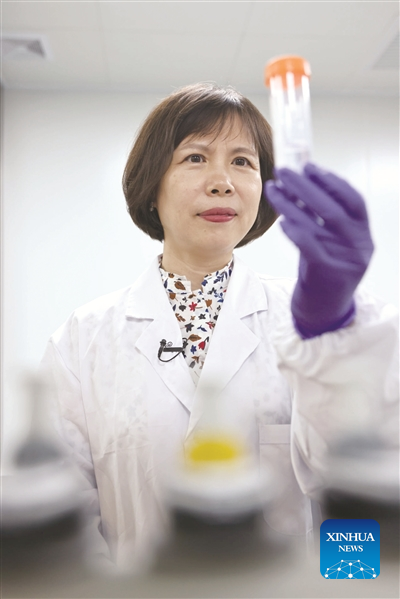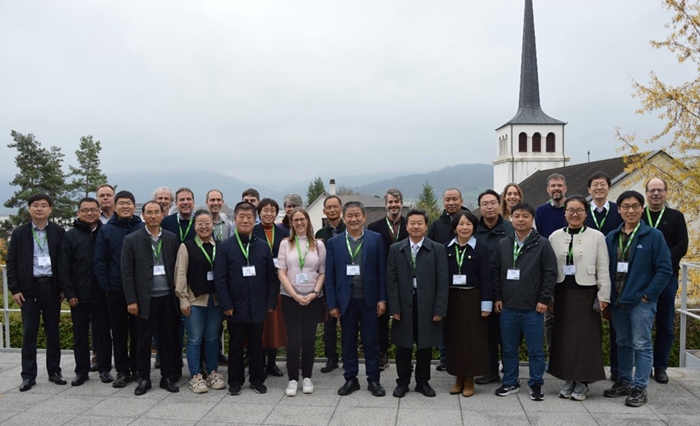[Xinhua] China Focus: Chinese scientists find new molecular target for creating green pesticides

This photo taken in December 2022 shows Yang Qing, a researcher with the Agricultural Genomics Institute at Shenzhen (AGIS) under the Chinese Academy of Agricultural Sciences (CAAS), conducting experiments at the AGIS in Shenzhen, south China's Guangdong Province.(CAAS/Handout via Xinhua)
A recent study by Chinese scientists has identified a new molecular target for developing safe and efficient green pesticides, offering a promising solution to combat pesticide resistance in pests.
Citing statistics from the United Nations Food and Agriculture Organization, researchers from the Chinese Academy of Agricultural Sciences (CAAS) noted that crop pests cause an estimated 40 percent loss in global agricultural production, resulting in economic losses exceeding 220 billion U.S. dollars each year.
"Reclaiming food from pests has become a challenging task," said Yang Qing, a researcher with the Agricultural Genomics Institute at Shenzhen (AGIS) under CAAS.
Various pest control methods, such as pesticide spraying, odor attraction and introducing natural enemies, have been tried, but the effectiveness of these measures has not been satisfactory due to the increasing resistance to pesticides and the high costs involved, Yang explained.
"We need pesticides specifically designed to target the unique structural features and physiological functions of pests. Known for their high specificity, safety, efficiency and lack of environmental pollution, these targeted pesticides are often referred to as green pesticides," Yang said.
The key to developing targeted pesticides lies in identifying appropriate molecular targets. Molecular targets are specific biological molecules or proteins at the molecular level that pesticides act upon, directly affecting the life activities of pests, Yang added.
The research team led by Yang has discovered a unique type of protein known as ABCH transporter.
Their study revealed that the ABCH protein is responsible for transporting lipids to the insect cuticle, contributing to the formation of the insect's lipid barrier. This protein is also linked to pesticide resistance in pests.
The ABCH protein is present in all insects and other arthropods, but absent in humans and other mammals and plants, making it an ideal molecular target for creating pesticides, according to the researchers.
The study uncovered a unique interaction mechanism between the ABCH transporter, lipid molecules and insecticide molecules. The researchers also obtained a small molecule inhibitor that can restrain the transport function of ABCH and identified effective ingredients that can be directly used in the synthesis of green pesticides.
This research marks a significant breakthrough in the fields of entomology and pesticide target studies, laying a crucial foundation for the development of green pesticides, Yang said.
The research findings have been published in the latest issue of the academic journal Cell.
-
 Dec 12, 2024Chinese Academy of Agricultural Sciences (CAAS) is launching the NARS Capacity Building through China-Africa Research Partnership Program
Dec 12, 2024Chinese Academy of Agricultural Sciences (CAAS) is launching the NARS Capacity Building through China-Africa Research Partnership Program -
 Dec 05, 2024China-CABI Project Development Workshop Held in Delémont, Switzerland
Dec 05, 2024China-CABI Project Development Workshop Held in Delémont, Switzerland -
 Dec 05, 2024Ministerial Workshop on Digital Agriculture and Rural Revitalization for BRI Partner Countries Held at CAAS
Dec 05, 2024Ministerial Workshop on Digital Agriculture and Rural Revitalization for BRI Partner Countries Held at CAAS -
 Dec 05, 2024CIAR and FGV Deepen Cooperation to Promote the Development of China-Brazil Green Agricultural Products Value Chain
Dec 05, 2024CIAR and FGV Deepen Cooperation to Promote the Development of China-Brazil Green Agricultural Products Value Chain -
 Dec 05, 20242024 Youth Hackathon for Urban Agriculture Finals Successfully Held in Beijing
Dec 05, 20242024 Youth Hackathon for Urban Agriculture Finals Successfully Held in Beijing
